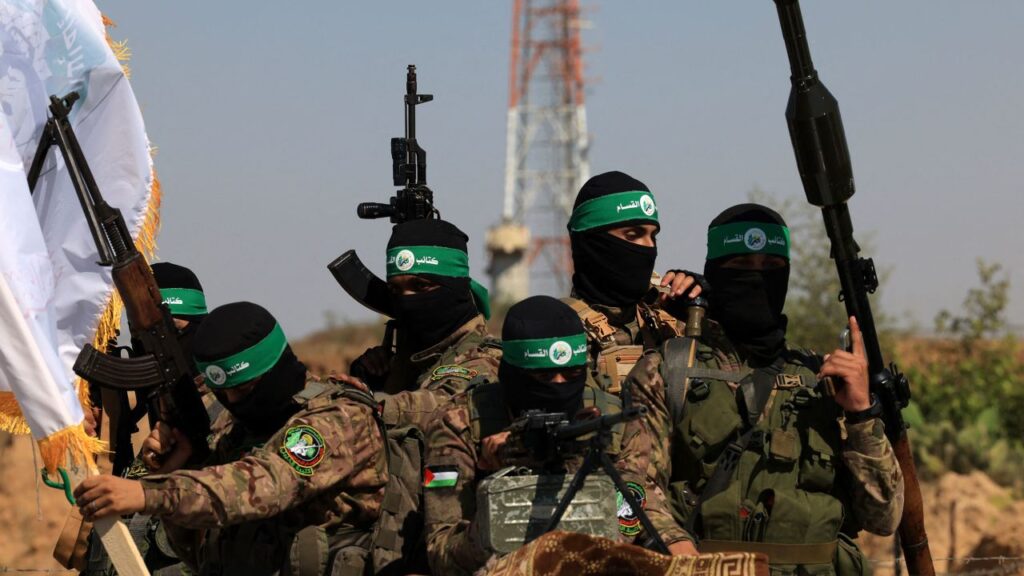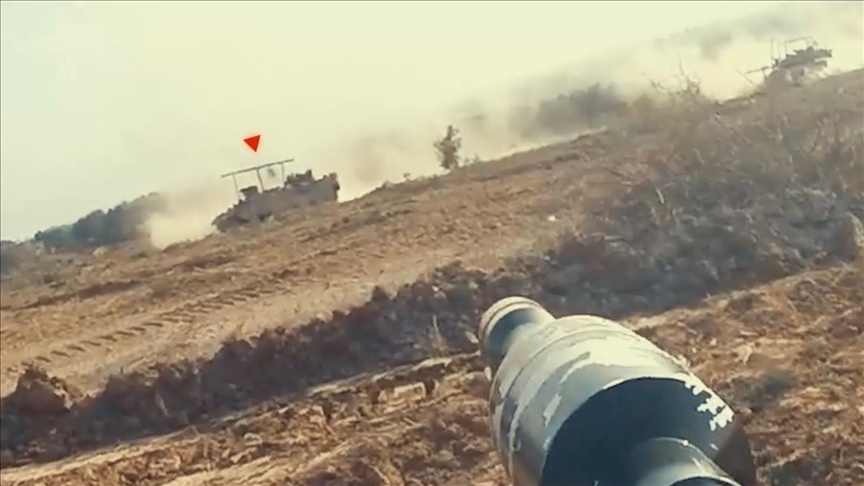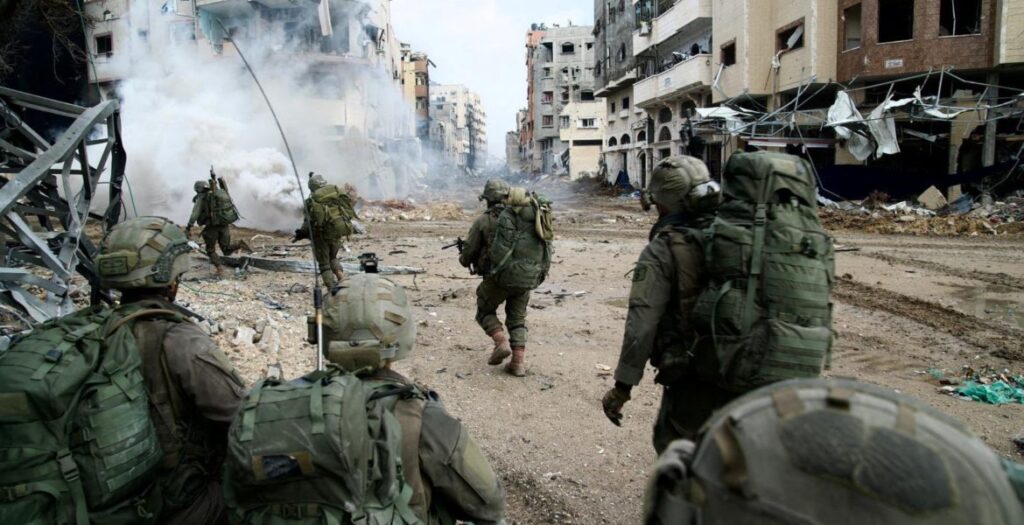Despite more than 230 days passing since the Israeli aggression on the Gaza Strip, the Palestinian resistance continues to achieve gains on the ground and to drain the Israeli occupation army, despite its claims of being able to eliminate the Hamas movement’s twenty brigades deployed in the sector from north to south.
Israeli military analyses have revealed how the Palestinian resistance has continued to inflict severe losses on the occupation army in recent weeks, after the occupation had bet on time as a means to exhaust the resistance. However, the opposite occurred, and the resistance succeeded in draining the occupation, as confirmed by Israeli experts.
Despite strict military media censorship, Israeli media outlets continue to publish daily reports from the field in Gaza, revealing the difficulties faced by Israeli soldiers in fierce battles with the resistance, including face-to-face confrontations.
The clashes with the Palestinian resistance in May alone resulted in the deaths and injuries of dozens of Israeli soldiers, alerting the occupation to the fact that “Hamas is still doing well.”
Recently, Israeli experts have focused on “taking stock” of the Israeli army’s failures in Gaza, especially in recent weeks, calling for the necessity of finding a “safe withdrawal” plan for the army from Gaza, or repositioning its forces there, fearing their vulnerability to Hamas snipers and fighters.
Among those advocating for this are Ron Ben Yishai, military affairs editor at “Yedioth Ahronoth” newspaper, former Israeli army operations division head General Israel Ziv, and former complaints commissioner in the army, nicknamed “Prophet of Wrath,” General Yitzhak Brick, who predicted the October 7th attack.
This was highlighted by headlines dominating Israeli newspapers and news bulletins, with some examples including:
- “Hamas is preparing an ambush for us in Rafah, and invading it will be the ‘trap’ awaiting us.
- Israel stands helpless against the terrifying Gaza deluge and seems stumbling as usual.
- The Gaza war is taking us from failure to failure, costing us dearly without benefit.
- Halting the Gaza war is the first step toward fixing the ‘failed brigade’s’ mistakes.
- “No absolute victory,” Hamas remains, and our leaders are failures.
- Where are the elite units, the warships, the tanks, and the artillery against Hamas fighters?
The draining of the Israeli occupation army
The latest confrontations revealed by the Palestinian resistance occurred in battles in Jabalia, north of the Gaza Strip, which resulted two days ago in the killing, injury, and capture of a number of occupation soldiers.
Meanwhile, these soldiers captured images from Rafah of the resistance rockets launched from among the tanks stationed on its lands, targeting Tel Aviv and Gush Dan in central Israel, as if the missile arsenal held by the movement had not been affected, despite launching tens of thousands of rockets during the past eight months.
This confirms that Hamas has succeeded in drawing the Israeli occupation army into a real and bloody war of attrition, as warned by Israeli military personnel, knowing that involvement in the Gaza quagmire will cost them unbearable losses.

It was clear from the beginning that the occupation did not adequately prepare its army for a ground invasion of Gaza, evidenced by Hamas’ thorough preparations to target its soldiers with bombs, explosives, and martyrdom operations as they approached residential neighborhoods, as well as efforts to “mine and booby-trap” the land and houses with bombs and explosives.
However, the army’s attempts to defeat Hamas and restore its lost deterrence often collided with a wall of resistance, with no signs of its breaking, meaning Israeli recognition of the difficulty of subduing it, as affirmed by Israeli experts and generals.
The peak of Israeli recognition came with the results of a recent opinion poll among Israelis, revealing that the majority believe Hamas has emerged victorious so far from the war, and that the Israeli army is unable to extract concessions from it to release its captives.
This comes amid the widening of weekly protests by Israelis demanding an end to the war and a deal with the movement, confirming that Israeli society no longer has the endurance, but rather succumbs to the blows of the resistance.
At the same time, the fierce resistance in Gaza in recent weeks has caused successive tremors within the Israeli political and military leadership, leading to loss of confidence, mutual suspicion, and harsh accusations.
Meanwhile, Prime Minister Benjamin Netanyahu continues to repeat his broken record about the “absolute victory,” despite Israeli acknowledgment that Hamas “has succeeded in disrupting their way of life, impacting their economy and external relations, has not been defeated, and logically, not being defeated is considered a victory.”
No strategy for the occupation army
Reports from the upcoming battles in Gaza have revealed that the Israeli occupation army, which inflicted extremely severe blows on Hamas to achieve its declared objectives, was surprised to find Hamas better prepared for the confrontation. Hamas had learned well its strategy and operational tools used in previous wars in Gaza, providing systematic responses.
Meanwhile, the army embarked on the war without an updated strategy, a successful initial strike, new operational ideas, or sufficient understanding of the enemy’s logic. It was well known that Israel’s goal was to defeat Hamas, achieve its downfall, and establish long-term deterrence to prevent a repetition of the October 7th attack.

However, the recent days of the war have lent more credibility to doubts that the occupation lacks an exit strategy to end the war, evident in the rampant Israeli chaos surrounding the dilemma of “the day after” in Gaza.
Israeli acknowledgments of the severity of the resistance in Gaza and its success in dragging the army into a harsh and bitter war of attrition have continued, leaving the Israeli army in a hysterical state during the recent weeks of the Gaza war, as Hamas fighters managed to kill Israeli soldiers in unprecedented numbers.
The paths of attrition in managing the battle and its strategic toll between Hamas and Israel in Gaza have been highlighted by several indicators, with one of the most dangerous being the army’s committing brutal crimes against civilians, hospitals, and public facilities to prevent any evidence of its defeat from emerging.
This was evident in the recent hours in the massacre in the Al-Khayam area of Rafah, preceded by a similar massacre in Jabalia, in addition to the resumption of rocket launches toward Israeli cities and their expansion after several months of cessation.
Israeli soldiers within reach of the resistance
But the new ongoing attrition in Gaza is that the Israeli soldier is now directly within reach of the Qassam fighters. They have sniped dozens of them and destroyed many vehicles and tanks in a short time.
These facts confirmed to a broad sector of Israelis that what they knew about Hamas during the Gaza war was completely different from what was narrated and disseminated in the media.
Increasing convictions among them during the war days indicate that “the movement will not surrender, will not raise the white flag, even if it has one fighter, one rifle, one rocket, and its fighters face death without hesitation, ready to die for their homeland, with an intense desire to fight, defending their homes, and ready to sacrifice everything dear and precious.”
The results of the recent battles in Gaza and the daily deaths of Israeli soldiers in the alleys of Gaza, Rafah, Jabalia, and Khan Yunis have sparked intense anger among Israelis, leaving them in a state of “nail-biting tension,” seeing that more than two hundred days of fighting have brought them back to square one, to the seventh of October, without achieving any of the battle’s objectives.
“Ghosts” emerging from tunnel openings
Israel did not hide its fear of entering into a war of attrition with Hamas in Gaza, due to the strategic and economic losses it would incur, especially amidst the escalating crisis of confidence between the government and the army.
This confirmed to the Israelis that despite suffering painful blows, Hamas remained resilient throughout the war, deeply rooted in the heart of Gaza, and forced Israelis to negotiate with it, meaning recognition of it as a legitimate player in the political equation. Meanwhile, more than half of Israel remains paralyzed, and its citizens are deeply disappointed and angry at their leadership.
The most dangerous description of the ongoing fighting in Gaza is that “Hamas behaves like a suicide bomber wanting to drag us into armed conflict, and the side that determines the extent of the military operations will prevail.”
Toughest wars for the occupation
While it’s true that the Israeli occupation army possesses immense military capabilities and overwhelming firepower, its list of visible targets has been exhausted or nearly so. It can no longer continue killing Palestinian civilians to compensate for its incapacity against the fighters or randomly destroying infrastructure, as it did during the eight months of aggression, because war crimes and genocide committed have been exposed to the global public opinion.
It has become difficult for the United States and other Western countries to justify and bear the repercussions of their actions, limiting their ability to prolong their war against Gaza and reducing their appetite for savage killing and destruction.

As for the resistance, it possesses advantages and capabilities aiding it in its war of attrition against the Israeli army. Its people have shown patience, resilience, and endurance despite the unbearable cost they have paid, and their military infrastructure built underground has defied the army despite the thousands of tons of missiles and explosives launched during the war.
Moreover, the resistance’s arsenal of short and medium-range missiles, diverse and abundant, enables it to wage a relatively long-term war of attrition, guided by the principle of “economy in ammunition.”
It was evident that Hamas had conducted highly advanced training and prepared well for the war, establishing an “underground city” in Gaza, forming special units, making significant progress in building its military strength, and acting disciplined towards the Israeli occupation army.
The Gaza war, with the military and political losses suffered by Israel, has been acknowledged as one of its toughest wars, by both official and public Israeli consensus, who were astonished by the exceptional capabilities demonstrated by the resistance in managing the battle and effectively using confrontation tactics.
The “resistance army” surprised the occupation
Israeli generals, commentators, and researchers listed aspects reflecting Hamas’s resilience in the war waged by the Israeli occupation army on Gaza, implicitly admitting that “the movement appeared as a state that managed to build an excellently organized army, with an effective central command structure and a military leadership prepared for war appropriately.”
They also see that the resistance “made great efforts and mobilized all its forces despite the difficult economic conditions in Gaza, in addition to launching an underground concealment network to secure the freedom of its fighters during military confrontations, and building a huge arsenal of missiles with multiple range levels capable of reaching any spot in Israel.”
The recent battles in Gaza showed that the Israeli occupation army is facing an enemy different from the image it had drawn in the minds of its soldiers, meaning that “Hamas managed to achieve a picture of victory in this war, or that it is on the way to achieving it because its success in closing the Israeli airspace to global aviation, even for a short period, is a picture of victory that will remain present in the collective consciousness of Palestinians and Israelis.”
As for the Israeli soldiers participating in the aggression on Gaza, stationed on its borders and in its heart, they did not hide that they spent terrifying nights on the outskirts of the sector after clashes with the resistance.
One of them, who engaged in ground battles that took place in Gaza, said, “I did not see any of the Hamas fighters we fought against. It was as if we fought against ghosts. We did not see soldiers, and we do not know where the bullets and rockets came from. It was terrifying nights by all measures. We searched for a military target, but we did not find anyone to fire at.”
Military circles described the clashes that erupted in the heart of Gaza as extremely violent due to the density of resistance fire, resulting in many casualties and injuries among the Israeli occupation forces in several scattered areas, prompting Israel to declare a state of alert in several of its hospitals in close proximity to receive dead and wounded soldiers from Gaza.
This situation revealed that the task of the Israeli occupation army in the sector is extremely difficult and dangerous because it feared that Gaza would be a gateway and a trap for the abduction of soldiers following unprecedented attacks by the movement, which demonstrated its skilled use of the element of surprise.
One of the senior officers in the Southern Command of the army confirmed, “The fierce battles fought by the army in Gaza have no precedent in its military history because they are the most complex.”
He added, “The resistance demonstrated by Hamas fighters in Jabalia and Khan Yunis surprised me. I know how to respect my enemy, even though he wants to kill me, but I respect the fighting spirit of the Palestinian fighters who have undergone training throughout the past period, prepared themselves well for this confrontation, and applied the slogan raised by Hamas, which is readiness to sacrifice and redeem for the sake of achieving the goal.”
Sunna Files Free Newsletter - اشترك في جريدتنا المجانية
Stay updated with our latest reports, news, designs, and more by subscribing to our newsletter! Delivered straight to your inbox twice a month, our newsletter keeps you in the loop with the most important updates from our website












